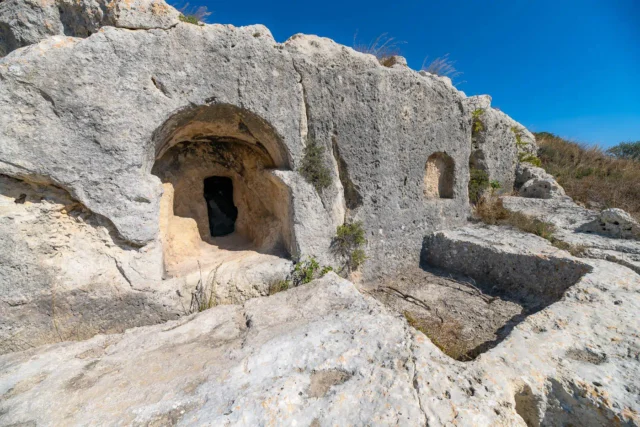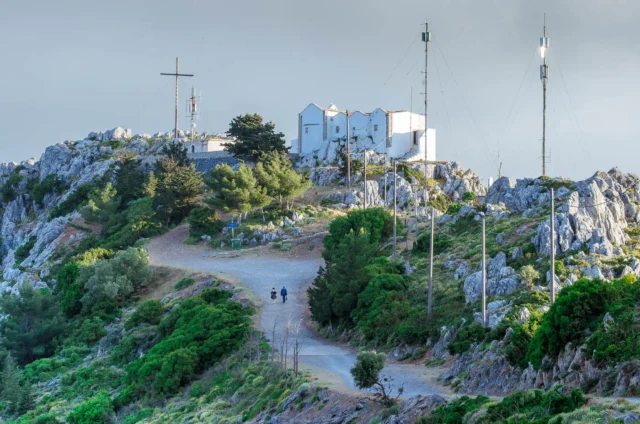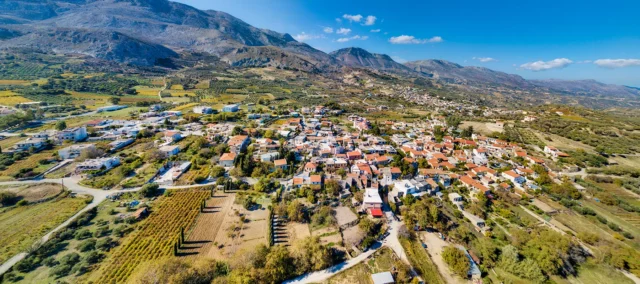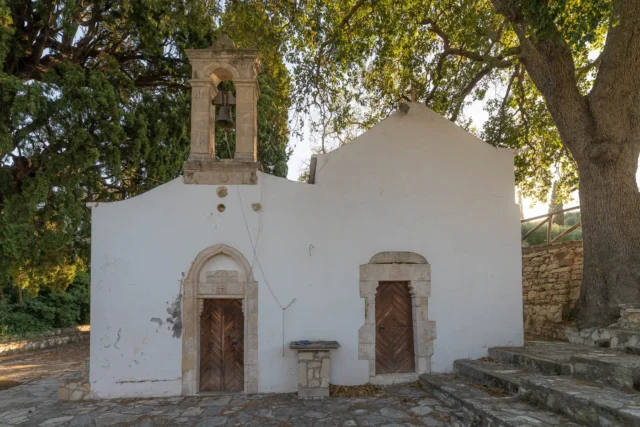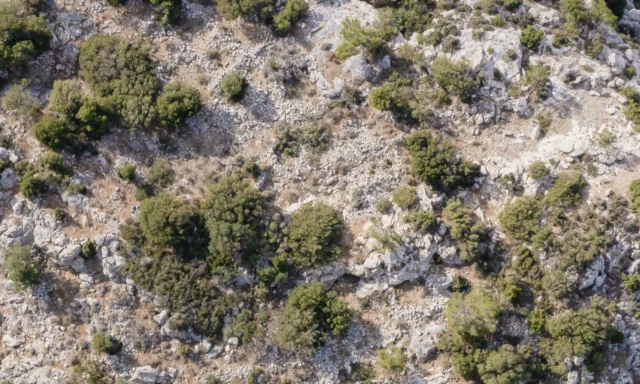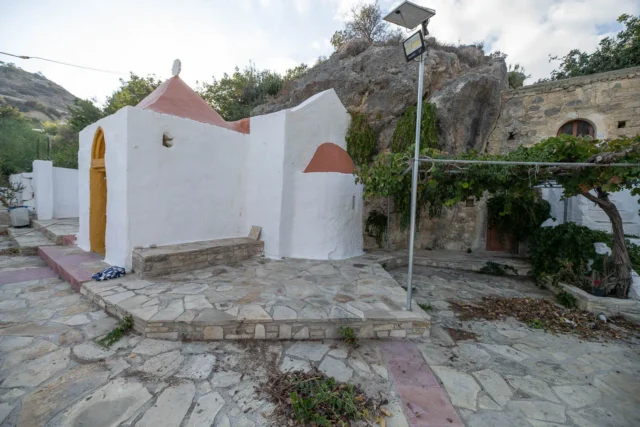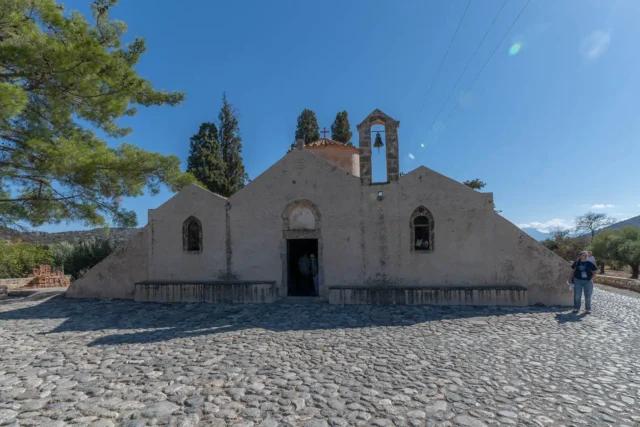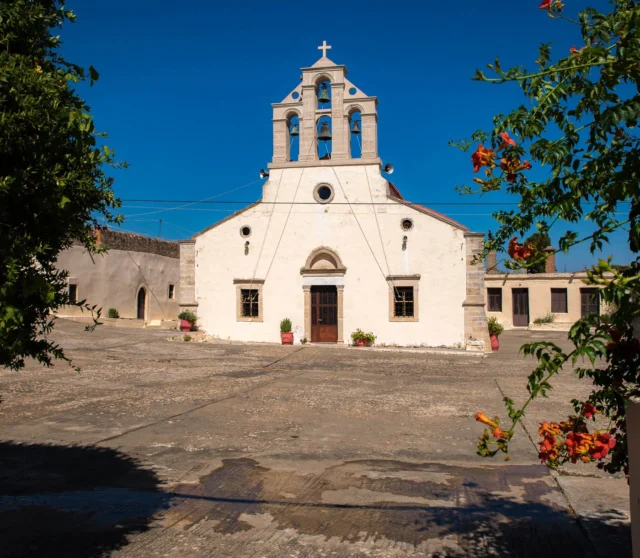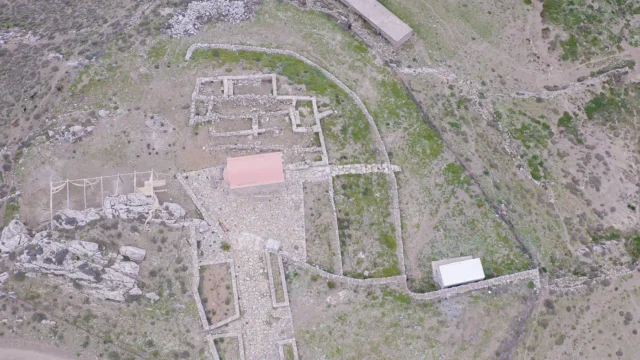829
listings found
Categories
Active filters:
Vakiotes Acropolis
The Vakiotes Acropolis, located east of Sokaras village near Velouli and Apoini in Crete, is an archaeological site with dwellings and tombs carved into the rock. This unique construction, along with finds like wine presses and a Roman-era tomb, suggests a long period of occupation from the Geometric period to the Turkish era. The site's name and evidence of wine production may link it to the god Bacchus. Archaeological investigations have uncovered a tomb with silver denarii from the reigns of Roman emperors Vespasian, Trajan, and Domitian. The surrounding landscape also features remnants of a church and an old windmill. Declared a protected archaeological site in 2001, Vakiotes Acropolis offers a glimpse into ancient construction techniques and daily life.
Giouchtas mountain
Giouchtas Mountain, a prominent 811-meter peak south of Heraklion, Crete, features significant Minoan peak sanctuaries, including Psili Korfi and Anemospilia, dating to the 2nd millennium BCE. Anemospilia's findings suggest possible human sacrifice. Associated with Zeus, it hosts the Afendi Christos church (1443). The mountain supports diverse flora (360+ species) and fauna (150+ bird species, including griffon vultures), within maquis and phrygana landscapes, and reforestation areas. Part of the Natura 2000 network, it faces pressures from urbanization and tourism. Hiking trails lead to viewpoints and historical sites, offering insights into Minoan civilization and natural biodiversity.
Ano Asites, Heraklion
Located at 480 meters on the eastern slopes of Mount Ida (Psiloritis) in Crete. The area's history is marked by a necropolis at Siderospilia with tombs from the Minoan to Roman periods and the remains of the ancient city of Rizinia. Mentioned in the 1583 Venetian census, it later became a haven for WWII resistance fighters like Manolis Bandouvas. The village is near the gorges of Agios Antonios and Agios Charalambos and is a starting point for the E4 walking path. It has a folk museum and celebrates its patron saint, Agios Ioannis, on August 29th.
Monastery of Kyria Chrysopigi in Pyrgou
Located near Pyrgou, Crete, this Greek Orthodox monastery is dedicated to the Life-Giving Spring (Zoodochos Pigi), reflecting its construction near a water source, and Saint Titus. Once a cenobitic monastery with workshops, its history is noted in a 1577 Venetian document. It survived the Ottoman conquest, functioning initially but later falling under the Monastery of Gorgolaιni. Renovations occurred in 1745 and 1796. The main church (katholikon) is double-aisled. Surrounding features include a stone olive millstone, winemaking remnants, graves from its time as a cemetery, and the original water source with a stone fountain. A stone bell tower dated 1908 stands nearby. Currently, only the katholikon remains, and the monastery is inactive.
Saint John the Theologian in Margarites
14th-century Byzantine church in Margarites, Crete, featuring frescoes from 1383.
Monastery of the Saviour Christ and Saint Gideon (Metochi Karakalou)
16th-century monastery in Margarites, Crete. Dependency of Karakalou Monastery, Mount Athos. Associated with Saint Gideon. Restored.
Agios Ioannis Theologos in Kritsa
Located between Kritsa and Kroustas in Crete, this settlement centers on the Monastery of Agios Ioannis Theologos, founded in the 10th century during the Second Byzantine period. Mentioned in a 1219 treaty, its fortified location served as a crucial refuge for rebels ("hainides") against the Venetians and Ottomans. In 1925, its cells were given to Asia Minor refugees. The monastery's katholikon is a triple-aisled basilica with a dome, featuring valuable Byzantine frescoes dated 1347-1348. The naves are dedicated to the namesake, the Metamorphosis tou Sotira, and Agios Charalambos. A 13th-century silver processional cross from the monastery is now housed in the Historical Museum of Crete.
Mesokastellas between Kalamafka and Anatoli
Mesokastellas Fortress: Byzantine ruins in the Dikti Mountains, Crete. Strategically positioned with panoramic views, occupied from prehistoric to Venetian times.
Monastery of Panagia Pantanassa Vagioneas
Located in the Vagioneas area near Anatoli, Ierapetra, this religious site is dedicated to the Life-Giving Spring. Originally a women's monastery founded in 1398 by the prominent anti-Catholic hieromonk Neilos Damilas, it housed a significant school. After Damilas's death, the monastery declined, with its properties transferred to the Patriarchate of Alexandria until 1870. Today, the only surviving structure is a small church, which combines a single-aisled cave church with an 1860 square narthex.
Panagia Kera in Kritsa
A three-aisled, vaulted Byzantine church near Kritsa, Lasithi, with a central dome. The aisles are dedicated to the Dormition of the Theotokos, Saint Anna, and Saint Anthony. Initially built in the Byzantine era, it was renovated in the 14th century, acquiring new frescoes in a Palaiologan style, and again in the 16th century. The interior contains two layers of frescoes from the 13th and 14th centuries, depicting the Christological Cycle, the Second Coming, and a rare image of Saint Francis.
Ancient Oleros
Oleros was an ancient Cretan city inhabited from the Early Iron Age until the Roman period. It was known for its olive oil production and political involvement in Crete.
Apezana Monastery
Apezana Monastery, located in Crete's Asterousia Mountains, is a 15th-century sanctuary dedicated to Saint Anthony. It features a fortified design, a church with a carved iconostasis, and a rich history intertwined with Cretan resistance and Orthodox faith.
Lasaia: An Ancient Cretan Town and Port
Lasaia, an ancient coastal town in Crete, was a vital port with a rich history spanning from the Minoan to Roman periods. Its well-preserved harbor complex played a crucial role in maritime trade and cultural exchange.
Axenti, abandoned village
Originally Agios Auxentios, this Cretan village existed since the Venetian era, with its 16th-century Church of Agio Pnevma. During the Ottoman occupation in 1732, the villagers converted to Islam, transforming into feared Janissaries known for their brutality. Following the Greco-Turkish War, the village was systematically destroyed in 1922 and has been abandoned since. The ruins and the church, which was converted into a mosque, serve as a historical landmark of this turbulent period in Cretan history.
Ancient Lato
Lato, an ancient city in Crete, reached its peak after the Dorian arrival. Named after the goddess Leto, Lato was strategically located on a hilltop overlooking the Mirabello Gulf. The city was heavily fortified, with strong walls, gates, and towers. Lato was one of the most powerful city-states in ancient Crete, with a well-organized political structure and a thriving economy. The city's port, Lato pros Kamara, facilitated trade and contributed to its growth. The archaeological site of Lato features well-preserved remains, including the agora, prytaneion, theater, temples, and private houses. Lato was eventually abandoned in the Roman era but was rediscovered in the late 19th and early 20th centuries. Today, it is a popular tourist destination, offering visitors a glimpse into the life of an ancient Cretan city. Lato was the birthplace of Nearchus, a famous admiral who served under Alexander the Great.
Elia, Chersonissos
Elia is a settlement located in the Heraklion regional unit on the island of Crete, Greece. It belongs to the Municipality of Chersonissos
Association for People with Special Needs (AMEA) “To Mellon” (The Future)
Association for People with Special Needs (AMEA) "The Future" in Faneromeni, Crete, empowers individuals with disabilities through therapeutic programs, sports, and accessibility initiatives.
Castel Bonifacio
Castel Bonifacio, or Epano Kasteli, in Crete, is a ruined fortress with Venetian and possibly Byzantine roots. Built by Enrico Pescatore, it served as a key Venetian stronghold, withstanding revolts like the Skordiles-Melissenos in 1230. Its architecture features fortified walls, square towers, and a central cistern. The site includes a ruined church and remnants of other buildings, reflecting its military and community functions. The fortress's decline began in the late Byzantine period, and the village of Tsifout Kasteli grew at its base. Archaeological research continues to uncover its layered history, highlighting its strategic role and architectural evolution.









